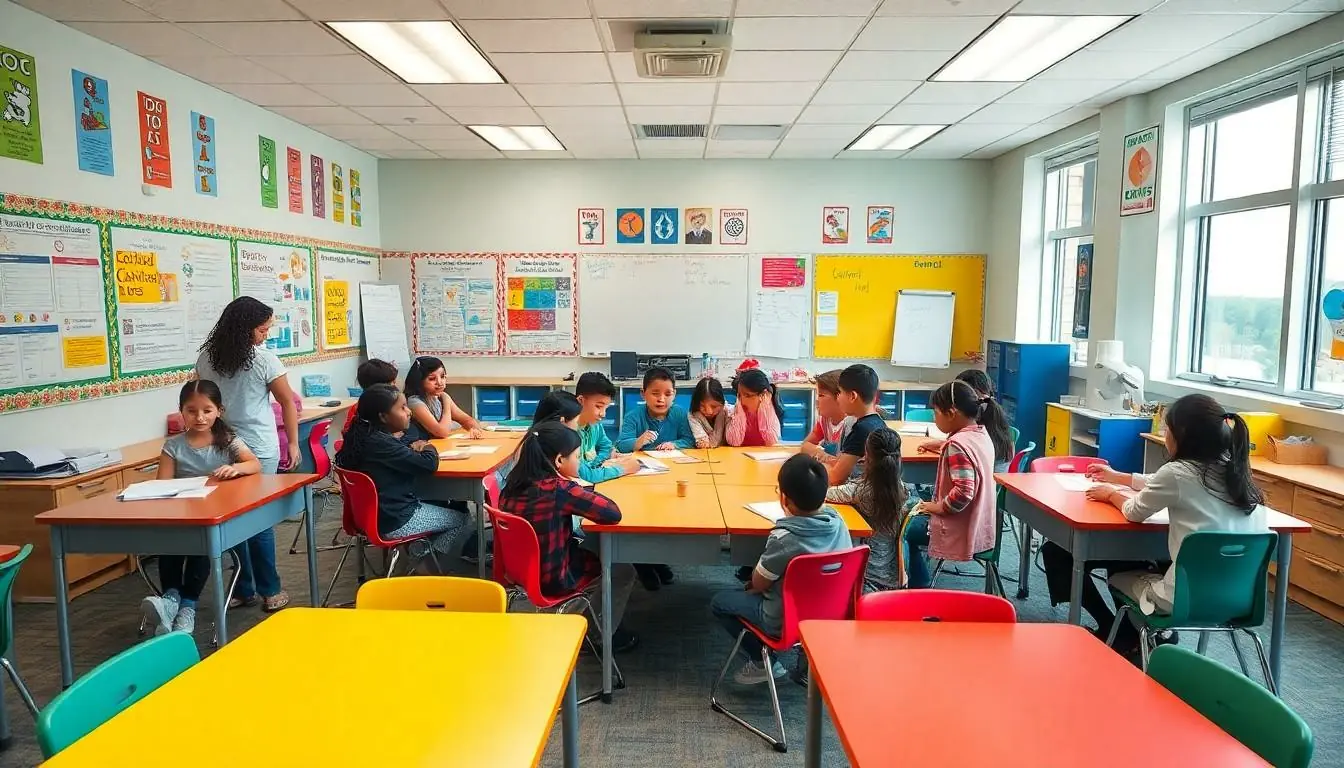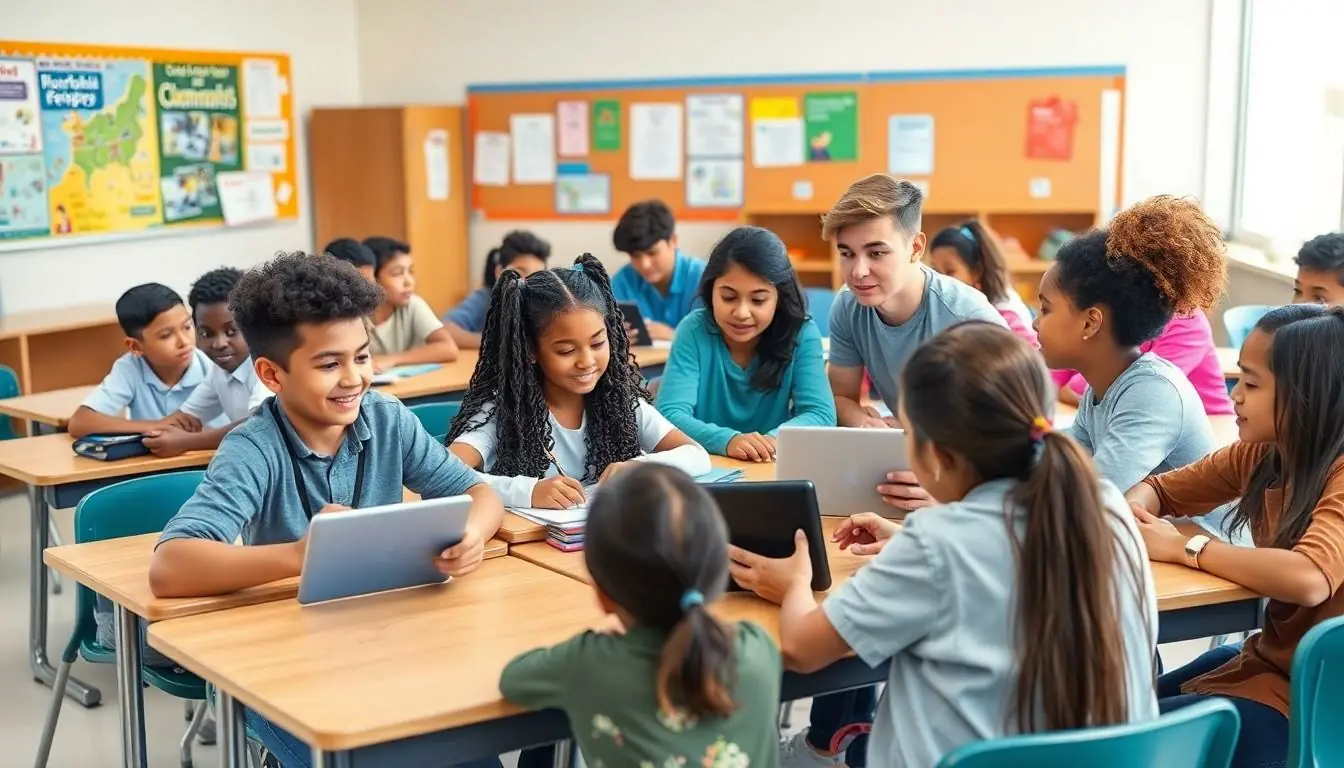Table of Contents
ToggleK-12 education in Illinois isn’t just about textbooks and tests; it’s a wild adventure through the land of learning. From the bustling classrooms of Chicago to the quiet halls of rural schools, students are navigating a curriculum that’s as diverse as the state itself. With a mix of challenges and triumphs, Illinois schools are shaping future leaders, thinkers, and maybe even the next great deep-dish pizza maker.
But let’s face it, navigating the K-12 landscape can feel like trying to find a parking spot at a Bears game—frustrating and overwhelming. With new policies, educational trends, and ever-changing technology, parents and educators alike are on a quest for the best strategies to ensure success. Fear not! This article dives into the ins and outs of Illinois’ K-12 system, making the journey a little less daunting and a lot more fun.
Overview of K-12 Education in Illinois
K-12 education in Illinois reflects a diverse array of experiences shaped by urban and rural contexts. The system faces ongoing challenges and celebrates notable successes in preparing students for future opportunities.
Historical Context
K-12 education in Illinois has evolved significantly since its inception. The state’s first public schools emerged in the early 19th century, driven by a commitment to universal education. Significant legislation, such as the Illinois School Code established in 1961, laid the groundwork for current educational frameworks. The launch of the Illinois State Board of Education in 1985 marked another milestone, focusing on improving student outcomes. Various reforms aimed at ensuring equity and access followed throughout the decades, including increased funding efforts in the 1990s. Trends in education reflect changing societal needs, highlighting the importance of adaptability within the system.
Current Structure
K-12 education in Illinois consists of a diverse network of districts serving approximately 2 million students. Public, private, and charter schools operate within the state, offering various educational experiences. The Illinois State Board of Education oversees public education, encompassing around 850 school districts. Key components of education include core curriculum standards, assessments, and teacher licensure requirements. Funding for education primarily stems from local property taxes, state appropriations, and federal support. Current initiatives focus on enhancing technology integration and addressing educational disparities across different communities.
Key Components of K-12 Education in Illinois

K-12 education in Illinois features essential elements that shape the learning experiences of approximately 2 million students. Understanding these components clarifies the landscape of education in the state.
Curriculum Standards
Curriculum standards guide educational direction in Illinois. The Illinois Learning Standards serve as a framework, covering subjects such as English language arts, mathematics, and science. These standards delineate what students should know and be able to achieve at each grade level. Instruction aligns with Next Generation Science Standards, emphasizing inquiry-based learning. Another focus includes enhancing critical thinking and problem-solving skills. Schools tailor their curricula to meet these state requirements while incorporating local needs and community input.
Funding and Resources
Funding structures heavily influence the quality of K-12 education in Illinois. Local property taxes typically account for about 60 percent of public school funding. State appropriations and federal support contribute additional resources but differ significantly between urban and rural districts. Disparities in funding often lead to varied educational experiences. Schools with more funding frequently offer advanced courses and extracurricular activities. Priorities include addressing these funding gaps through targeted state initiatives and grants aimed at equitable resource distribution. Collaborations between districts and community organizations enhance the availability of educational resources.
Challenges Facing K-12 Education in Illinois
Various challenges impact K-12 education in Illinois, complicating efforts to create an equitable learning environment for all students.
Equity and Access Issues
Equity issues significantly affect student outcomes across different districts. Disparities often arise from funding, with local property taxes generating about 60% of public school revenue. Urban areas typically experience higher funding levels compared to rural regions, leading to unequal access to resources. Technology access also varies greatly; some districts offer advanced tools while others lack basic infrastructure. Students in low-income households face barriers that hinder participation in educational opportunities, such as extracurricular activities and advanced coursework. Illinois state initiatives aim to bridge these gaps, yet substantial challenges remain in ensuring every student receives a quality education.
Teacher Shortages
Teacher shortages pose another critical challenge in Illinois K-12 education. Many districts struggle to retain educators, particularly in underserved areas. Factors contributing to this crisis include low salaries, demanding workloads, and limited professional development opportunities. Approximately 10% of teaching positions remain unfilled, leading to larger class sizes and increased stress for remaining staff. This shortage disproportionately affects disadvantaged students who rely on qualified teachers for guidance and support. Recruitment efforts must prioritize building a diverse teaching workforce, enhancing job satisfaction, and providing incentives to retain educators in high-need areas.
Innovations and Improvements in K-12 Education
K-12 education in Illinois continues to evolve, embracing innovative strategies to enhance learning experiences. These initiatives focus on technology integration and community engagement.
Technology Integration
Technology integration becomes essential in modern classrooms. Schools across Illinois adopt tools like tablets and interactive software to foster engagement. These resources not only support personalized learning but also prepare students for a tech-driven workforce. Approximately 90% of schools now emphasize integrating digital platforms into daily lessons. As a result, educators better capture students’ attention while promoting critical thinking skills. Data from the Illinois State Board of Education highlights how this shift helps bridge knowledge gaps between socio-economic groups. Schools using technology effectively report improved student outcomes and engagement levels.
Community Engagement
Community engagement plays a vital role in enhancing K-12 education. Schools partner with local organizations and businesses to provide resources and support. These collaborations create mentorship opportunities and diverse learning experiences for students. About 70% of districts in Illinois actively involve parents and community members in decision-making processes. Initiatives like school open houses and volunteer programs strengthen these connections. Engaging the community fosters an environment of shared responsibility for student success while addressing issues of equity and access. Collaborative efforts have shown measurable improvements in student motivation and academic achievement.
K-12 education in Illinois stands at a pivotal moment. The ongoing efforts to address equity and access reveal a commitment to improving educational experiences for all students. By leveraging technology and fostering community engagement, schools are creating more inclusive environments that prepare students for future challenges.
The focus on core curriculum standards and innovative teaching practices demonstrates a dedication to enhancing academic achievement. As stakeholders continue to collaborate and address the pressing issues of funding disparities and teacher shortages, the potential for transformative change in Illinois’ educational landscape remains strong. With the right strategies in place, the future of K-12 education in Illinois looks promising for every student.




